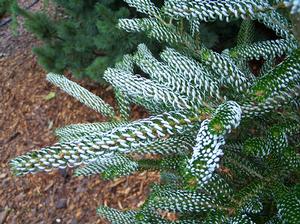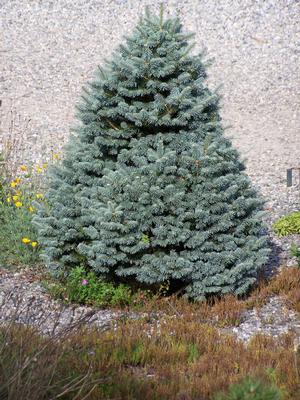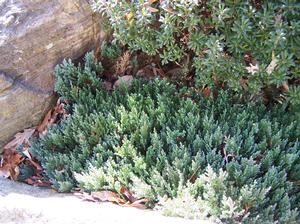
Abies koreana 'Silberlocke'

Abies lasiocarpa 'Arizonica Compacta'

Juniperus horizontalis 'Grey Forest'
Gray and Silver Conifers: Shadow and Light
This quote from Joni Mitchell’s song Shadows and Light illustrates the view I hold for silver and gray conifers:
“Every picture has its shadow
And it has some source of light…”
I see icy silvers as bright light and cool grays as shadow. Just as a passing cloud may be a foreboding lead-gray while the verge catches the sunlight reflecting a blinding silver-white, so can these cool-colored conifers create light and shadow in ones garden.
Silver and gray colors are neutral (relative to how much blue may be in the gray). In a too busy garden, gray and silver conifers can act like a sip of cold water between meal courses which clean the taste buds and in turn allows you to better enjoy each bite. Gray tones, used to advantage with quieter shades, will soothe and calm. Employed well they can create an air of contemplative peace and aid in restful retreat from a too busy world. Grays are most often chromatic gradients to blue shades and are lovely with purples. Add some pink to grays, blues and purples and you will warm those cooler shades, mix in some silver and light the garden!
Silver spices dazzle onto greens. In a hot color garden of oranges, reds and sharp yellows silver plants can actually excite a scheme by throwing ice into a mix of too much riotous color. In so doing you may create a less-busy viewing experience yet curiously at the same time one that sizzles more.
Silver and gray conifers may even fool the eye by creating the illusion of depth; that is, a gray conifer might lead the eye to feel there is recess where there is actually none. Silver conifers conversely may stand out seemingly in the foreground belying the flat fact upon closer inspection. Awareness of such optical trickery can provide an opportunity to create the feeling of greater space. For instance, placing a silver conifer slightly forward next to a gray one set a little further back in a shallow foundation planting will lead one to perceive greater depth than is real.
Think of the following list of plants as a palette of paints, each plant a different and subtle color choice within the framework of silvers and grays. Consider that these might be possible brush stokes within the portraits of your gardens. Consider each of these additions as dabs of shadow or accents of light…
Abies koreana ‘Silver Show’, ‘Hortsmann’s Silberlocke’ (‘Silvercurl’) and ‘Silberreif’ – Korean Fir. The curved, upturned needles display more of the silver-white undersides than the green tops. The astonishing effect when the sun’s angle is just right is that of a shimmering silver conical tree that appears as if it had been screwed into an electric light socket! Though these moments are fleeting and all too rare they will burn into your memory with white hot intensity. Abies koreana bears large erect violet-purple cones, another wonderful feature. Of the three, ‘Silberreif’ shows off the most silver but not by much; they are all exceptionally beautiful. Forget those aluminum Christmas trees from the 1950s as these will never become tacky kitsch! Desired use, the size of your garden and the quickness with which you would like it to grow will determine your choice. ‘Hortsmann’s Silberlocke’ would make a striking anchor for Crocosmia ‘Lucifer’, Hemerocallis ‘Tuscawilla Tigress’ (Daylily) and Alstroemeria ‘Sweet Laura Variegated’ (Peruvian Lily). You might back it with Artemesia ludoviciana ‘Silver King’ (Wormwood) with a handsome carpet of Stachys byzantina ‘Silver Carpet’, a non-flowering form of Lamb’s Ears in the foreground to tie it all together.
Classification*: ‘Hortsmann’s Silberlocke’ is Dwarf growing generally from 1 ½ to 3 inches per year, possibly more in optimum conditions. And as with many conifers once it reaches a certain size it can pick up speed. ‘Silverreif’ is also considered Dwarf and is said to grow faster than ‘Silberlocke’. ‘Silver Show’ transitions soon from Dwarf to Intermediate status and it grows even faster than the previous 2 cultivars.
Height x Width: Except for ‘Silver Show’ of which there are reports of specimens 20 feet tall, I have no size determinations.
Light: Full Sun
Soil: Cool, moisture retaining acid soils
Zone: 5 to 6(7)
Applications: Conifer Collection, Rock Garden, Perennial Garden, Shrub Border, Heath and Heather Garden, Foundation, Specimen, Allee (‘Silver Show’), Mixed Hedgerow
Abies lasiocarpa ‘Arizonica Compacta’ (syn. ‘Glauca Compacta’) – Arizona Cork Bark Fir, Alpine Fir. This compact Alpine Fir from the western United States forms a handsome little upright cone. It will be more rounded as a young plant but develops into a perfect little pyramid made of soft blue-green and silvery needles on dense branches. It is unfortunate that this plant is somewhat confused in the trade, often displaced with the greener and much larger growing ‘Compacta’. I have planted one in my xeric garden set in a mulch of crushed stone in gray tones adjacent to Clematis freemontii, a collection of Sempervivum (Hens and Chicks) and Delosperma basuticum, a South African mat-forming evergreen succulent with nickel-sized satiny yellow daisy-disc flowers in abundance.
Classification*: Dwarf
Height x Width: 4 feet tall by 2 feet across over many years
Light: Full Sun
Soil: Well-drained, tolerates drought well once established
Zone: 5 to 6(7)
Applications: Conifer Collection, Rock Garden, Perennial Garden, Shrub Border, Foundation, Mixed Hedgerow, Xeric Garden
Chamaecyparis pisifera ‘Squarrosa Minima’ (syn. ‘Squarrosa Intermedia’) – Sawara Cypress. This form of Sawara Cypress grows into a soft congested rounded dome composed of cool blue-gray mossy foliage. Reversions should be pruned out to keep it small and tight. If you let it revert it will eventually grow into a large, wild and shaggy upright shrub. For a soothing and satisfying scenario partner it with Carex morrowii ‘Silver Scepter’, Campanula portenschlagiana (Creeping Bellflower) and the upright accent of Juniperus communis ‘Compressa’ (Dwarf Common Juniper).
Classification*: Miniature to Dwarf
Height x Width: 20 inches tall by 20 inches across in 10 to 12 years
Light: Full to ¾ Sun
Soil: Moisture retaining soils that drain well.
Zone: 4 to 8
Applications: Conifer Collection, Rock Garden, Perennial Garden, Shrub Border, Heath and Heather Garden, Foundation, Mixed Hedgerow, Miniature Railroad Garden, Bonsai, Topiary, Knot Garden, Labyrinth
Juniperus horizontalis ‘Grey Forest’ – Rug Juniper. This interesting little shrub grows upright branchlets from the main horizontal stems that snake along the ground. Each erect branchlet cloaked in medium to dark gray foliage resembles a tiny tree. En masse this Rug Juniper resembles a miniature forest, hence its name. In winter it shades handsomely to dark gray infused with an infusion of purple. This unusual juniper is not common in commerce but as it becomes better known I expect it will gain popularity. ‘Grey Forest’ would be nicely used in a trough where it will overhang the sides in just a few years’ time. It can be maintained in a trough if carefully pruned to keep it in scale where it looks like molten lead spilling over the edges. Or when it outgrows the trough you might transplant it into a xeric garden near a light colored boulder where its dusky dark gray shade will contrast handsomely.
Classification*: Miniature
Height x Width: 6 inches tall by 10 inches across in 10 years
Light: Full Sun
Soil: Well-draining with sand added. Prefers dry, even xeric conditions
Zone: 4 to 9
Applications: Conifer Collection, Rock Garden, Trough, Perennial Garden, Heath and Heather Garden, Foundation, Miniature Railroad Garden, Xeric Garden, Knot Garden, Labyrinth
Juniperus scopularum ‘Gray Gleam’ – Western Red Cedar, Rocky Mountain Juniper. The symmetrical, narrow upright form will make a terrific accent in a garden. In time it will grow into a fat exclamation point. Grayish foliage in summer gives way to a particularly beautiful winter silver-gray. This lovely shrub is shadow in summer but light in winter! It is a male form and will not produce berries. ‘Grey Gleam’ will be unsurpassed as an upright element contrasting other lower, mounding conifers in a collection. A pair at the entrance of a formal walk would be a stately addition. Juniperus scopularum has not fared well for us in northeastern Connecticut; though perfectly hardy for us it may have to do with the seasonal set-up of temperatures and rainfall. Juniperus scopularum nativity is North Dakota south to Texas, all states west except California and in Saskatchewan, Alberta and British Columbia.
Classification*: Intermediate
Height x Width: 5 to 6 feet tall by 15 inches across in 10 years, 15 to 20 feet tall by 5 to 7 feet across in 35 years.
Light: Full Sun
Soil: Well-draining. In acid soils the addition of lime will be beneficial.
Zone: 3b to 7
Applications: Conifer Collection, Perennial Garden, Shrub Border, Heath and Heather Garden, Foundation, Specimen, Hedge, Allee, Mixed Hedgerow, Topiary, Formal Garden
Juniperus viginiana ‘Grey Owl’ – Eastern Red Cedar. Discovered in a batch of Juniperus virginiana ‘Glauca’ seelings ‘Grey Owl’ is thought to be a hybrid between between J. v. ‘Glauca’ and J. x media ‘Pfitzeriana’. The wide-spreading branches covered in light gray foliage are handsome year-round. The female forms will produce rather large berries nearly the same color as the foliage. The “baubles” will add another subtle textural element on an already handsome plant. Use it as a large groundcover to hide an unsightly piece of ground. An unusual application would be to employ it in an over-sized labyrinth at the end of a formal walkway on a larger piece of property. That would certainly raise some eyebrows!
Classification*: Dwarf to Intermediate
Height x Width: 2 to 3 feet tall by 6 feet across
Light: Full Sun to ½ Shade
Soil: Moisture retaining soil that drains quickly, drought tolerance once established
Zone: (3b?)4 to 9
Applications: Conifer Collection, Shrub Border, Large Heath and Heather Garden, Foundation, Large Groundcover, Mixed Hedgerow, Large Knot Garden, Large Labyrinth
Picea mariana ‘Nana’ – Black Spruce. This cute conifer forms a low dome of gray-blue needles. Its form reminds me of a small happy, fat mammal all settled into our Heath and Heather Garden. I wouldn’t be without this special plant. It would be the shadow for the sunlight of Erica carnea ‘Foxhollow’, a white-flowered, yellow-foliaged Heath that sports some coral pink in winter and Kalmia latifolia ‘Elf’ (dwarf Mountain Laurel).
Classification*: Miniature
Height x Width: 1 foot tall by 1 ½ feet across in 10 to 12 years, 1 ½ feet tall by 3 feet across at maturity
Light: Happiest in Full Sun
Soil: Moisture retaining and humus laden soils
Zone: 3 to 5(6)
Applications: Conifer Collection, Rock Garden, Perennial Garden, Shrub Border, Heath and Heather Garden, Foundation, Mixed Hedgerow
Pinus koraiensis ‘Silveray’ – Korean Pine. ‘Silveray’ grows into a simply beautiful upright pyramidal column. Found at Rotterdam Arboretum in Holland this elegant tree will furnish distinction wherever it is planted. The first time I set eyes on a lovely small specimen of long-needled pine it took my breath away. It should be in every collection. Carefully placed as a taller specimen in a mix of layered smaller shrubs and dwarf conifers it would be a tremendous focal point.
Classification*: Slow in its early years - Dwarf to Intermediate, Large eventually
Height x Width: 5 feet or so in 10 to 12 years
Light: Full Sun
Soil: Well-drained with moisture retaining humus added
Zone: (3)4 to 7
Applications: Conifer Collection, Large Rock Garden, Perennial Garden, Shrub Border, Heath and Heather Garden, Foundation, Specimen, Mixed Hedgerow
Pinus sylvestris ‘Argentea Compacta’ – Scots Pine. Pinus sylvestris ‘Argentea Compacta’ develops into a compact silvery-gray pine. Though lovely in all seasons it is especially beautiful in spring when the new growth (“candles”) sprouts erect. This very slow growing cultivar should not be confused with P. s. ‘Argentea’ which is a large, upright conifer... take not of the 'Compacta'. Plant this little “porcupine” in a sunny rock garden with clusters of Achillea x kellereri (silver fern-leaved yarrow with white flowers to 6 inches), Allium ‘Mt. Sinai’ (a large-flowered lavender pink ornamental onion on 12 to 14 inch stems) and Dianthus amurensis ‘Andrey’ (a small, single carnation [“pink”] with large, light purple flowers). Throw in a few blue Scabiosa japonica (Japanese Pin Cushion) to round it out.
Classification*: Miniature
Height x Width: Undetermined but definitely slow as it only grows as much as 1 ½ inches per year
Light: Full Sun
Soil: Well-drained with drought tolerance when established
Zone: 3 to 7a(7b)
Applications: Conifer Collection, Rock Garden, Perennial Garden, Shrub Border, Heath and Heather Garden, Foundation, Mixed Hedgerow, Miniature Railroad Garden, Knot Garden, Labyrinth
Sequoidendron giganteum ‘Hazel Smith’ – Giant Sequoia. This Giant Sequoia, adorned in short gray foliage which shows off the handsome branching patterns is architecturally gratifying. The bark contrasts in rich red-brown. Introduced by Robert Fincham from Sandy, Oregon circa 1988, ‘Hazel Smith’ grows very quickly into a tall and broad specimen tree. She is alleged to have greater hardiness than the straight species which is supposed to be hardy only to Zone 6. But Dirr reports that the species has survived minus 22F in Scandinavia. That being true ‘Hazel Smith’ will probably do well in New England Zone 5 as it has performed very well for us. An allee of S. g. ‘Hazel Smith’ on a large property – oh my, that would be sight one would not soon forget!
Classification*: Large
Height x Width: Probably 60 feet tall by 25 to 30 or so feet wide in the east, much larger in its native haunts.
Light: Full Sun
Soil: Humus-laden moisture retaining soils
Zone: 5 to 8
Applications: Large Conifer Collection, Specimen, Allee, Large Screen
Look at your gardens with an artist’s eye. Remember: silvers will cool down a “too bright” color scheme. Grays engender serenity and peace. Will an element of gray here and silver there better define and underscore the visual and spiritual experience inherent in your gardens? I have suggested a painter’s palette. Available are many more silver and gray conifers in varying textures, shapes and heights from which to choose. Put your own palette together, whatever works best for you. Then spring into action. Devise your landscapes until you’ve created the perfect picture with your signature upon it. In the gallery of your gardens mix in some grays for depth and silvers for icy brilliance. Add some elegance and class with shadows and light.
*The American Conifer Society’s growth rate categories are as follows:
-
Miniature: up to 1 inch per year. Estimated size in 10 to 12 years is up to 1 foot.
-
Dwarf: average rate of 1+ to 6 inches per year. Estimated size in 10 to 12 years is 1+ foot to 6 feet.
-
Intermediate: average rate of 6 to 12 inches per year. Estimated size in 10 to 12 years is 6 to 12 feet.
-
Large: average rate of 12 or more inches per year. Estimated size in 10 to 12 years is 12 feet or more.
Penned by Wayne Paquette, February 2006